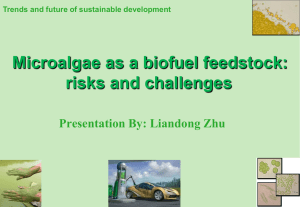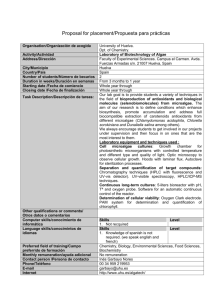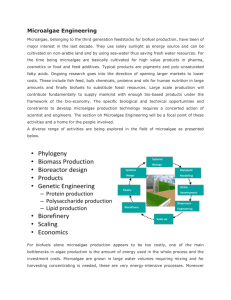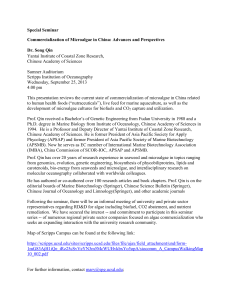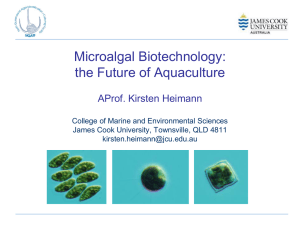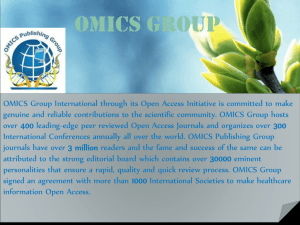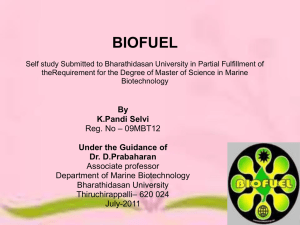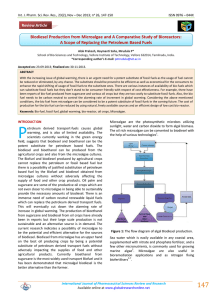PPT Slide Show
advertisement
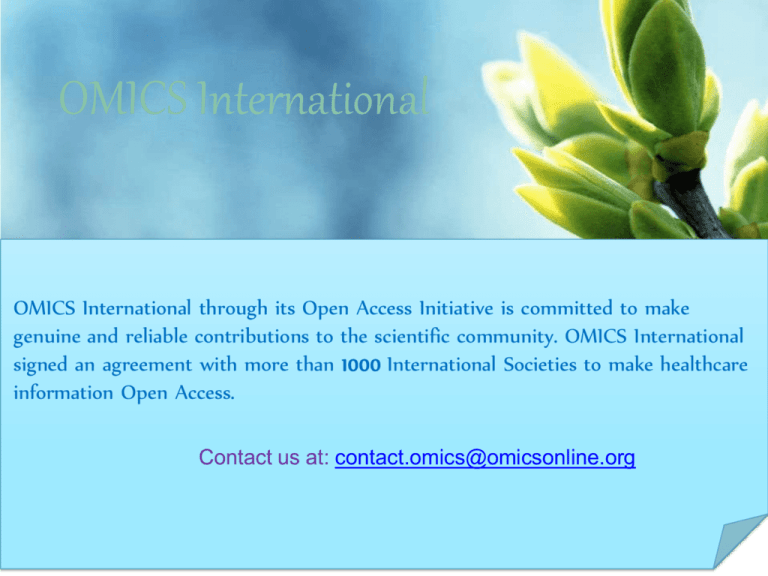
OMICS International OMICS International through its Open Access Initiative is committed to make genuine and reliable contributions to the scientific community. OMICS International signed an agreement with more than 1000 International Societies to make healthcare information Open Access. Contact us at: contact.omics@omicsonline.org OMICS Journals are welcoming Submissions OMICS International welcomes submissions that are original and technically so as to serve both the developing world and developed countries in the best possible way. OMICS Journals are poised in excellence by publishing high quality research. OMICS International follows an Editorial Manager® System peer review process and boasts of a strong and active editorial board. Editors and reviewers are experts in their field and provide anonymous, unbiased and detailed reviews of all submissions. The journal gives the options of multiple language translations for all the articles and all archived articles are available in HTML, XML, PDF and audio formats. Also, all the published articles are archived in repositories and indexing services like DOAJ, CAS, Google Scholar, Scientific Commons, Index Copernicus, EBSCO, HINARI and GALE. For more details please visit our website: http://omicsonline.org/Submitmanuscript.php LAM MAN KEE Editor PPT Biography • Dr. Lam Man Kee is currently working at the Department of Chemical Engineering, Universiti Teknologi PETRONAS, Malaysia. • His research interests include biodiesel and bioethanol production technology, microalgae cultivation, catalysis and life cycle assessment. Recent Publications • Lam, M. K. & Lee, K. T. (2014). Cultivation of Chlorella vulgaris in a pilot-scale sequential-baffled column photobioreactor for biomass and biodiesel production. Energy Conversion and Management, 88, 399-410. • Lam, M. K. & Lee, K. T. (2012). Microalgae biofuels: A critical review of issues, problems and the way forward. Biotechnology Advances, 30, 673-690. • Lam, M. K., Lee, K. T., & Mohamed, A. R. (2009). Sulfated tin oxide as solid superacid catalyst for transesterification of waste cooking oil: An optimization study. Applied Catalysis B: Environmental, 93(1-2), 134-139. Fuel: Current environmental and social issues Fossil fuel Renewable fuel Air pollution Food vs fuel Water pollution High cost Green house gas effect Deforestation Acidification Biodiesel sources Non-Edible Oil Edible Oil Biodiesel Microalgae as the third generation of biofuel Microalgae -One of the oldest living microorganism on Earth - More than 30,000 species - Freshwater & Marine - Main constituents in the microalgae cell: Lipids Carbohydrate Biodiesel Bioethanol Advantages of microalgae biofuel -Does not compete with food supply -Relatively high lipid productivity compared to terrestrial oil plants Microalgae -> 54-126 tonne/ha/year Palm oil -> 3.62 – 10 tonne/ha/year Jatropha -> 0.14 - 4.13 tonne/ha/year - High photosynthetic efficiency -> Able to utilize CO2 efficiently - High growth rate -> 100 times faster than land based plant Cultivation of microalgae biofuel Light Water Nutrients Carbon An ideal microalgae biofuel production flow Sunlight Free and abundantly available Wastewater as nutrient source CO2 mitigation CO2 CO2 CO2 Alternative carbon source CO2 from flue gases CO2 Biofuel production Biodiesel production from microalgae lipid Transesterification Crude microalgae lipid Microalgae biodiesel Sequential Baffled Photobioreactor (SBP) 100 liter cultivation – Pilot scale 10 cm 140 cm 170 cm 30 cm The flow of bubbles in the baffled system CO2 Drainage Sparger CO2 SBP: Microalgae cultivation under indoor and outdoor environment Indoor Outdoor Problems with microalgae cultivation for biofuel production Availability of nutrients source: Nitrogen & Phosphorus • Chemical nutrients – high cost not environmentally friendly • Wastewater – inconsistent nutrients concentration serious contamination Availability of carbon source: CO2 • Atmospheric air – low concentration, 0.03 % • Flue gas – toxic compounds: CO, NOx, SOx high temperature: 65oC-450oC Problems with microalgae cultivation for biofuel production • Life cycle energy balance – not well understood • Economic potential - not well understood • Feasibility of outdoor cultivation Related Journals Chemical Sciences Journal Chemical Engineering & Process Technology Signature: OMICS International Open Access Membership OMICS International’s Open Access Membership enables academic and research institutions, funders and corporations to actively encourage open access in scholarly communication and the dissemination of research published by their authors. For more details and benefits, click on the link below: http://omicsonline.org/membership.php
